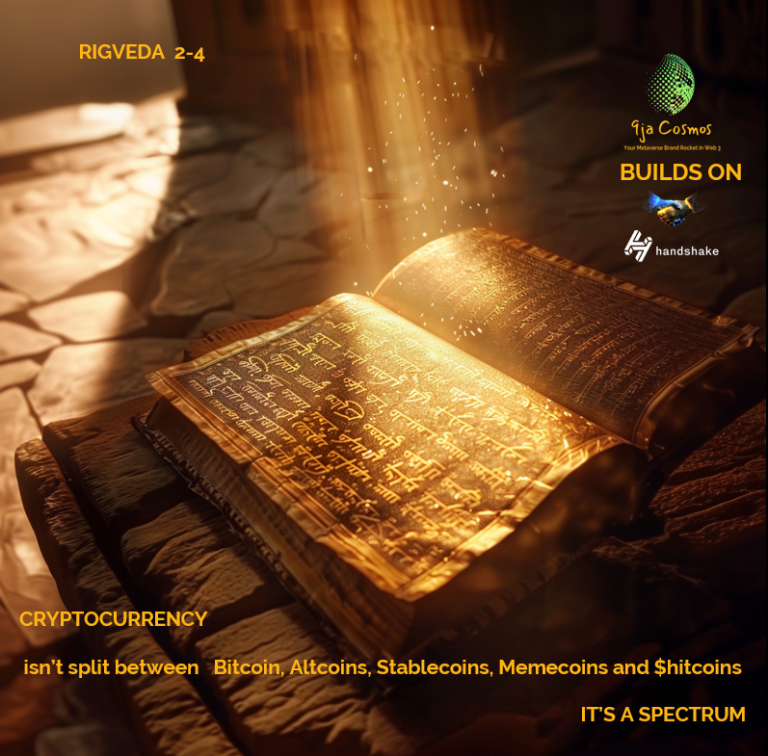
PRELUDE:
There are many misconceptions in the world of Cryptocurrency, which generally breaks down into two groups – Coins and Tokens.
Most of these misconceptions come from ‘Pop Talk’ in Web 3. Rigveda 2-4 acts to sort this out.
Register for Tekedia Mini-MBA edition 19 (Feb 9 – May 2, 2026): big discounts for early bird.
Tekedia AI in Business Masterclass opens registrations.
Join Tekedia Capital Syndicate and co-invest in great global startups.
Register for Tekedia AI Lab: From Technical Design to Deployment (next edition begins Jan 24 2026).
CATEGORIES OF MISCONCEPTION:
Bitcoin: Bitcoin is the oldest well known blockchain. The coin is generated through a process called ‘mining’. It uses a very specific PoW (Proof of Work) mechanism incorporating ‘Nakamoto Consensus’ named after the suspected creator, Satoshi Nakamoto.
The design is public information, and so, other blockchains have been created which are almost identical. Loyal proponents seem to dismiss that these variations or similes are what they are.
Altcoins: ‘Altcoin’ is a subjective word that means different things to different people depending on who you ask. The broadest possible interpretation is that any cryptocurrency not Bitcoin is an ‘Altcoin’.
This does not make sense, as some cryptocurrency labelled ‘altcoins’ exhibit Bitcoin properties, including ‘Nakamoto Consensus’
Some Bitcoin supporters’ conflict themselves by making technical arguments when comparing Bitcoin to a ‘FIAT’ such as the US Dollar, and then failing to confine themselves to similar technical arguments, when claiming other cryptocurrency holds no value.
There has never been an invention or innovation in human history which successfully argued (rather subjectively) that it is the only one that ‘deserves’ to exist. It didn’t work for Coca Cola, it didn’t work for Ford, it didn’t work for IBM Computers, and it won’t work for Bitcoin.
As STEM (Science, Technology, Engineering and Mathematics) ideological arguments were made to differentiate Bitcoin from a FIAT, so STEM ideological arguments need to be made to distinguish between individual cryptocurrencies, one of which may be Bitcoin.
Collectively naming many cryptocurrencies ‘Altcoin’ simply because they are not Bitcoin, is not rational.
Stablecoins:
Stablecoins are often anything but ‘stable’. They began as a bridge between cryptocurrency and FIAT when there was more reluctance in the market.
Web3 began to expand, and new CEXs (Centralized Exchanges) struggled to secure a geo-diverse licence portfolio, and keep up with an explosion of currencies, particularly project tokens.
Stablecoin providers jumped into a ready market, being a go between for FIAT currency and an obscure world of ‘virtual value’.
Bitcoin visibility was significantly lower than it is today, and viewed as part of that obscure world.
Stable coins offered the strongest ‘notion’ of security in an unsure space. They claim to ‘peg’ to a familiar and accepted value unit, such as $USD or gold.
The peg concept is indeed ‘notional’. Convoluted wizardery often exists in how this ‘peg’ is interpreted. They come from a commercial company, not an autonomous decentralized source, there may be structures that resemble ‘quantitative easing’, and there are redemption caveats that shield them from a ‘run’ faced with declining demand in an ‘over-supply’ challenge.
This story of Tether (USDT) should be taken as an anchor narrative to understand Stablecoin Risk.

Again, that something is called a stablecoin does not define how it is technically structured. The criteria is purely about the presence of the ‘peg’. Some things can be called ‘Stablecoins’ with no ‘STEM narrative’ to prove they are similar.
Stablecoins are probably ok as a transaction tool in a small holding window. Ticking time bombs should never be used as a store of value.
‘In practice, … stablecoin issuers have yet to be proven to maintain adequate reserves to support a stable value, and there have been a number of failures with investors losing the entirety of the (fiat currency) value of their holdings.’ – Wikipedia
Memecoins: Memecoins are a genre of cryptocurrency that originated from internet memes, often featuring animated characters or animal images. It’s a commonly stated distinction – ‘All coins are tokens but most tokens are not coins. ‘
Coin issue is a function of the core activities of a blockchain. The blockchain type and tokenomics has a significant impact on the value of a coin. Currency Tokens [not coins], are on the other hand created through various off-chain architectures using ‘smart contracts’, for example, those using ERC 20 in the ‘EVM Compatible’ space.
The problem with the term ‘memecoin’ is it doesn’t make clear if it’s a coin or a token. It doesn’t define whether it has utility, use cases or simply nothing.
Being a ‘memecoin’ doesn’t preclude the crypto from having other attributes. On it’s own, the ‘meme’ phenomenon will only attract ‘impulse investors’ in a tight window. With other attributes it may endure.
The Memecoin Genre, is probably the most ill-defined of cryptocurrency labels in ‘Pop Talk’.
$hitcoins: $hitcoins again, are a very ill-defined genre.
$hitcoins can be cryptocurrencies created for no real reason or purpose, often with little to no value. They typically have low market capitalization and are prone to crashing and burning. Some common features of shitcoins include:
- Speculative and volatile: Shitcoins are often created to speculate on market trends, leading to rapid price fluctuations.
- Lack of real-world use: Shitcoins rarely have a clear purpose or practical application, making them less valuable. They lack utility and use case.
- Unserioius from the start: Many shitcoins are created as jokes or parodies, with names and branding that poke fun at the crypto market. Most memecoins are also considered $hitcoins.
$hitcoins are generally off-chain tokens rather than coins which are the function of a blockchain core. The origin of the name ‘$hitcoin’ comes from the investing experience of the token reaching an ATH (ALL TIME HIGH) price rapidly after issue, and then abruptly going to zero ($hit).
Coins which are the function of a blockchain core, are expected to have an enduring value, and while they can become severely depressed, they don’t head to zero. Most have an architecture that can be used to build.
‘Bitcoin Maxis’ sometimes muddy the water by dismissing many cryptocurrencies as ‘$hitcoins’ in a similar way they perceive ‘altcoins’.
$hitcoins can also be tokens released to exit Founders and/or VCs from (poorly conceived) projects. ‘Rug Pulls’ happen when open market token purchases provide the opportunity for Founders and/or VCs to bail, and then token price plumets.
The PopTalk –‘$hitcoin’ has no clear technical criteria, so a deep dive is needed on any opportunity that stimulates interest.

Rigveda 2-4 and ‘The 9ja Cosmos Way’:
We ignore the PoP Talk and the hype, and call Cryptocurrency as we see it. We say what STEM principles say they are.
You can talk about different types of food, but what are the classifications? You will probably get different answers whether you choose to ask a Wholefood consumer, Dietician, Additives critic, Food Toxicologist, Nutritionist, or a Vegan !
Is Bitcoin a ‘store of value’? Well not if the person you ask is solely interested in Ordinals!
Nothing created by humans is ever perfect, but some creations are just built better, and endure better than others and the world of Cryptocurrency is no different.
What efforts have creators done to make a coin issuance impregnable once it’s put in place, free from vulnerabilities of human actions of some sort later?
How limited is the issue?
What durability qualities does it have?
How safe is your ‘value’?
Bitcoin is just a ‘brand’, and clarifying you hold ‘Altcoins’, ‘Stablecoins’, ‘Memecoins’ or ‘$hitcoins’ answers none of these questions.
Cryptocurrency types:
Autonomous – Limited Issuance
Here, the coin is issued by a self-sufficient blockchain on ‘auto-pilot’. It is completely independent – not controlled by others or by outside forces. The tokenomics design enforces a pre-programmed pace at which coins are issued into circulation, which will stop at a finite and limited maxiumum.
So far, only a ‘Nakamoto Consensus’ PoW (Proof of Work) Blockchain can achieve this type of coin. The most famous example is Bitcoin. There are others, such as Litecoin, Handshake and Ravencoin.
Autonomous – (Inflationary) Controllable Issuance
Here, the coin is issued by a self-sufficient blockchain on ‘auto-pilot’. The design may offer limited control to trusted entities defined by design policy and tokenomics . The tokenomics design enforces a pre-programmed pace at which coins are issued into circulation. Supply is not always limited, but issue tokenomics are cemented to architecture and supply growth is predetermined and predictable. Supply alteration by custodians can be difficult. Inflationary components are rigidly mathematically contrived to provide liquidity support for ecosystem growth, but are not arbitrary, in, for example, how a nation may respond with ‘money printing’ to a Debt Ceiling scenario.
Several PoW and PoS (Proof of Stake) blockchains can produce variations on these types of coins.
Variable Issuance
Here, the cryptocurrency may be issued by a self-sufficient blockchain (coin), or may be native to an off-chain architecture, though not a smart contract token. The design offers considerable control to trusted entities defined by design policy and tokenomics. The tokenomics design allows coin issuance in response to custodian led triggers . Supply is not limited, though bound by a function of the architecture and not arbitrarily issued through smart contracts.
A mix of non-PoW blockchains and other cryptographic architectures are capable of this coin.

Off-chain and non-native tokens.
There are many different types of tokens. They are created according to a prescriptive method called a protocol. Tokens are not an integral result of a blockchains’ ‘ordinary’ functioning.
A protocol method is created through a group of people creating and completing an IP (Improvement Proposal) for a blockchain. Tokens have been used for many things including NFTs, Gaming Assets, deeds to mass data, event ticketing, RWAs (real world assets, and more).
In this case we concern ourselves with token protocols used to carry out transactions, or value retention. The protocol ‘ERC 20’ is in use for this purpose in architecture extensions and networks operating with or compatible to Ethereum, known as EVM Compatible. Token volume and any asset base it may represent are entirely in the hands of commercial network owners.
In some cases, the network the token is driving may be deemed to have or be developing valuable virtual products, but in some other cases, it may have just a notion, idea, or simply nothing. They loosely resemble equities, though network owners token management specifically is not answerable to any stock exchange, issuance governance, shareholder authority or corporation compliance. They can dilute the issuance with ease, and without consultation.
In cases where ‘Memcoins’ or ‘$hitcoins’ are being discussed, it is invariably these types of Off-chain and non-native tokens rather than (blockchain) coins at all.
This group, represents the most misleading of all of such assets, to be homogenized under the heading ‘cryptocurrency’.
also:
Rigveda 2 – 1 : Web 3 is as an ‘End-to-End Decentralized UX’ [user experience]
Rigveda 2 – 2 : ‘There isn’t, wasn’t and won’t be a Web2’
Rigveda 2- 3 : ‘Whether a token in Web3 is an ‘NFT’, does not depend on the asset it has title to. It depends on the token protocol leveraged to create it.’
9ja Cosmos is here…
Get your .9jacom and .9javerse Web 3 domains for $4 at:
Preview our Sino Amazon/Sinosignia releases (Ente)
Preview our Sino Amazon/Sinosignia releases (Pinterest)
Visit 9ja Cosmos LinkedIn Page



